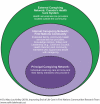"If you understand you cope better with it": the role of education in building palliative care capacity in four First Nations communities in Canada
- PMID: 31208402
- PMCID: PMC6580639
- DOI: 10.1186/s12889-019-6983-y
"If you understand you cope better with it": the role of education in building palliative care capacity in four First Nations communities in Canada
Abstract
Background: In Canada, there is a growing need to develop community-based, culturally appropriate palliative care for Indigenous people living in First Nations communities. The public health approach to palliative care, which emphasizes community-based initiatives, is especially relevant in First Nations communities because care is grounded in their distinct social and cultural context. Central to the public health approach are educational strategies that strengthen communities' capacity to care for their vulnerable members as they die. This paper presents community-based research conducted with First Nations communities in Canada that aimed to assess and address local palliative care educational needs to improve community capacity in palliative care.
Methods: Participatory action research (PAR) was conducted with four First Nations communities in Canada over a six-year period (2010-2016). The research occurred in three phases. Phase 1: focus groups, interviews and surveys were employed to assess community specific needs and resources. Phase 2: recommendations were developed to guide the PAR process. Phase 3: educational resources were created to address the identified educational needs. These resources were implemented incrementally over 4 years. Ongoing process evaluation was employed, and revisions were made as required.
Results: Educational needs were identified for patients, families, community members and internal and external health care providers. A wide and comprehensive range of educational resources were created to address those needs. Those culturally appropriate educational resources are available in a very accessible and useable workbook format and are available for use by other Indigenous people and communities.
Conclusions: This research provides an example of the public health approach and offers implementation strategies around palliative care education. This paper contributes to the international literature on the public health approach to palliative care by presenting a case study from Canada that includes: conducting a culturally appropriate assessment of educational needs, creating recommendations, facilitating development and implementation of educational resources in the community to improve community capacity in palliative care.
Keywords: Aboriginal; Capacity development; Community development; Education; First Nations; Indigenous; Palliative care; Public health approach.
Conflict of interest statement
The authors declare that they have no competing interests.
Figures




Similar articles
-
Developing palliative care programs in Indigenous communities using participatory action research: a Canadian application of the public health approach to palliative care.Ann Palliat Med. 2018 Apr;7(Suppl 2):S52-S72. doi: 10.21037/apm.2018.03.06. Ann Palliat Med. 2018. PMID: 29764173
-
Wiisokotaatiwin: development and evaluation of a community-based palliative care program in Naotkamegwanning First Nation.Rural Remote Health. 2018 Apr;18(2):4317. doi: 10.22605/RRH4317. Epub 2018 Apr 28. Rural Remote Health. 2018. PMID: 29724108
-
Celebrating indigenous communities compassionate traditions.Ann Palliat Med. 2018 Jan;7(Suppl 1):AB005. doi: 10.21037/apm.2018.s005. Ann Palliat Med. 2018. PMID: 29402099
-
Conversations on telemental health: listening to remote and rural First Nations communities.Rural Remote Health. 2011;11(2):1656. Epub 2011 Apr 19. Rural Remote Health. 2011. PMID: 21553998 Review.
-
Issues in health policy for indigenous peoples in Canada.Aust J Public Health. 1995 Dec;19(6):559-66. doi: 10.1111/j.1753-6405.1995.tb00459.x. Aust J Public Health. 1995. PMID: 8616195 Review.
Cited by
-
Demoralization and Its Association with Quality of Life, Sleep Quality, Spiritual Interests, and Suicide Risk in Breast Cancer Inpatients: A Cross-Sectional Study.Int J Environ Res Public Health. 2022 Oct 6;19(19):12815. doi: 10.3390/ijerph191912815. Int J Environ Res Public Health. 2022. PMID: 36232107 Free PMC article.
-
Naming racism as a root cause of inequities in palliative care research: a scoping review.BMC Palliat Care. 2024 Jun 10;23(1):143. doi: 10.1186/s12904-024-01465-9. BMC Palliat Care. 2024. PMID: 38858646 Free PMC article.
-
Inequities in access to palliative and end-of-life care in the black population in Canada: a scoping review.Int J Equity Health. 2024 Apr 25;23(1):81. doi: 10.1186/s12939-024-02173-9. Int J Equity Health. 2024. PMID: 38664833 Free PMC article.
-
A critical examination of 'family' caregiving at the end of life in contexts of homelessness: Key concepts and future considerations.Palliat Care Soc Pract. 2025 May 13;19:26323524251336765. doi: 10.1177/26323524251336765. eCollection 2025. Palliat Care Soc Pract. 2025. PMID: 40371322 Free PMC article.
-
Palliative care training programmes for community volunteers working with children and their families: a scoping review.Front Public Health. 2025 May 16;13:1469854. doi: 10.3389/fpubh.2025.1469854. eCollection 2025. Front Public Health. 2025. PMID: 40453503 Free PMC article.
References
-
- EOLFN [Improving end-of-life care first nations communities research team]. EOLFN Project Website https://eolfn.lakeheadu.ca/. Accessed 12 Sept 2017.
-
- World Health Organization. WHO Definition of palliative care. http://www.who.int/cancer/palliative/definition/en/. Accessed 12 Sept 2017.
-
- Canadian hospice palliative care association . The way forward National Framework: a roadmap for an integrated palliative approach to care. 2015.
MeSH terms
Grants and funding
LinkOut - more resources
Full Text Sources
Medical
Molecular Biology Databases

